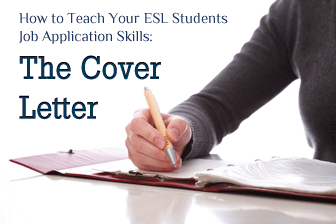How to Teach Your ESL Students Job Application Skills: The Cover Letter


I responded that I thought that would come out in the interview. At this, my friend pointed out that there was usually little time in a thirty-minute interview for these details, and while such details as committee and volunteer work might actually be a deciding point in interviewing someone, they were rarely the focus of the interview itself. This conversation represented a sea-change in my view of cover letters and resumes: as screening devices that determined whether a person gets interviewed, while the interview determined whether the individual gets hired.
Some cultures, for example, don’t have a complex hiring process as in the U.S. Rather, people are more or less “placed” in jobs after college. Still other cultures rely more on networking and family connections. While all of these systems exist to a more or less degree in most societies, in the U.S.’s system hiring is largely competitive, where employers put out their call for employees, and then job seekers compete for these positions, sometimes hundreds of applicants for one vacancy. It is in this context that cover letters and resumes should be taught. The purpose of the cover letter and resume is to make the job seeker look good—in fact, so good that the potential employer wants to meet the job seeker and interview him or her because this is simply the best candidate for the job.
What are some ways to teach students about cover letters and resumes? There are a few ways as follows:
Because students may unfamiliar with our job hunting process, which varies from culture to culture, explain a little bit what job applicants can expect to go through in looking for a job. You may consider using your own experience in job hunting. After students understand the process, then they will understand the purpose of writing a cover letter and resume, and having a writing purpose is critical to good writing.
At this point, now that they understand the job hunting process, students are ready to learn about cover letters, the job applicant’s introduction of himself or herself to a specific company for a specific job. It is usually addressed to a specific person, the contact person from the job announcement, and outlines some of the applicant’s skills that are particularly important to the job. The purpose of the cover letter is to get the reader to take a second look at the resume. If the instructor has a sample cover letter to show students, this can help them in designing their own cover letters.
If the purpose of the cover letter is to attract attention to the resume, the resume’s purpose is to motivate the company to call in the applicant for an interview. Therefore, the instructor should now hand out a collection of “help-wanted” advertisements, either from the newspaper or internet. Students should all select one, from a field in or one related to that they would themselves eventually like to work in. Once the students have advertisements, they should design a rough draft of their resume based on their advertisements. So if my advertisement reads “Teacher needed to teach a summer English class in intensive, six-hour blocks,” I will want in my resume to highlight the experience that demonstrate the skills of teaching English in intensive, short-term formats. I will not, in this resume, focus so much on my skills and experience as a writer as that is not so relevant to the job sought.
Again, showing students an example resume is helpful.
Do the cover letter and resume get applicants the job? No, in most cases. The purpose of the cover letter and resume is to get applicants an interview, and that is what job seekers should be thinking about at this stage—how to write a great cover letter and resume to get an interview. It is the interview that may get the applicant the job.
It’s the content that matters, right, not the appearance of the cover letter and resume? Actually, as with most things in life, appearances do matter. The content matters too, of course. But if the resume is so riddled with spelling and grammar errors that the interviewer can’t see past them to the content, or the bizarre, spiky font of the cover letter hurts the interviewer’s eyes and she doesn’t want to read it, then the content won’t matter because the reader is stuck on the bad “packaging.” So students should not feel obligated to be “creative” in format and should have a teacher or friend look over their cover letters and resumes before sending them out.
As a last step, have students practice writing cover letters and resumes to the job announcements they have chosen. They can do rough drafts in class, having a peer look them over. They can then take them home to write the final drafts, using their peers’ feedback, turning them in the next class session. Some students may be interested in actually sending theirs out to the employer! Even if they don’t send them out, students will have created their first resumes which can, in the future, be tailored for real job searches.
However, by explaining the job hunting process, placing resumes and cover letters into the context of this process, reviewing various examples, and practicing, some of the mystique will be removed, and your students will move one step closer to becoming employed.
Have you ever taught cover letter and resume skills? If so, what methods did you use?